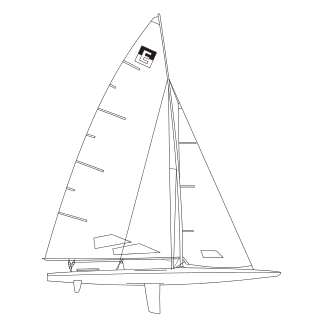
The Lightning is an American sailing dinghy that was designed by Olin Stephens of Sparkman & Stephens, as a one-design racer and first built in 1938.
The Comet, sometimes called the Comet OD or Comet One-Design, is an American sailing dinghy that was designed by C. Lowndes Johnson as a one-design racer and first built in 1932. The design has evolved over time via modifications.

The Jet 14 is an American sailing dinghy that was designed by Howard Siddons as a one-design racer and first built in 1952.
The A Scow is an American scow-hulled sailing dinghy that was designed by John O. Johnson as a racer and first built in 1901.
The MC Scow is an American sailing dinghy that was designed as a one-design racer and first built in 1956.

The M Scow, also called the M-Scow and the M-16 Scow, is a Canadian/American sailing dinghy that was designed by Johnson Boat Works and Melges Boat Works as a one-design racer and first built in 1950.

The E Scow is an American sailing dinghy that was designed by Arnold Meyer Sr as a one-design racer and first built in 1924.
The Rhodes 19 is an American trailerable day sailer or sailing dinghy, that was designed by Philip Rhodes as a one-design racer and first built in 1958.

The X Boat, also called the Cub, is an American sailing dinghy that was designed by John O. Johnson as a one-design racer and first built in 1932.
The Coronado 15 is an American sailing dinghy that was designed by Frank V. Butler as a one-design racer and first built in 1968.
The Interlake is an American planing sailing dinghy that was designed by Francis Sweisguth in 1932, as a one-design racer and first built in 1933.
The Interclub Dinghy is an American sailing dinghy that was designed by Sparkman & Stephens as a one-design racer and first built in 1946. It is sailed in frostbite racing on the US east coast, particularly on Long Island Sound. Frostbite races are the series held after the normal sailing season is finished.
The Howmar 12, sometimes written Howmar Twelve, is an American sailing dinghy that was designed by Craig V. Walters of Sparkman & Stephens as a one-design racer, trainer and day sailer and first built in 1983.
The Skipjack 15 is an American sailing dinghy that was designed by Harry R. Sindle and Carter Pyle and first built in 1965.
The US1, sometimes written US 1, is an American sailing dinghy that was designed by Ralph Kuppersmith and Clark Mills as a one-design racer and first built in 1973.
The AMF Apollo 16 is an American sailing dinghy that was designed by Canadian Bruce Kirby as a one-design racer and first built in 1977.
The Rebel 16 is an American sailing dinghy that was designed by Ray Greene and Alvin Youngquist as a one-design racer and first built in 1948.
The Dolphin 17 is an American trailerable sailboat that was designed by Glenn Corcoran and Murray Corcoran and first built in 1970.
The Pearson 23C is an American trailerable sailboat that was designed by William Shaw as a cruiser and first built in 1983.
The Santana 2023 is a family of American trailerable sailboats that was designed by Steve Schock, with models for racing and cruising, first built in 1993.






